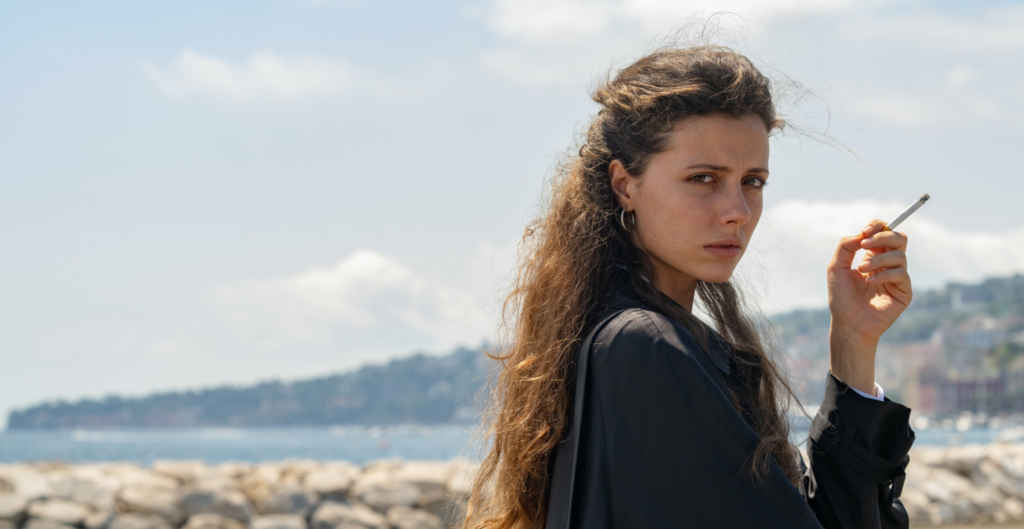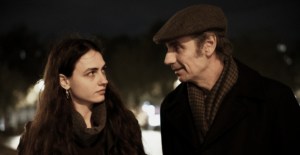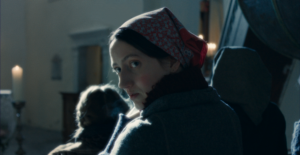Parthenope
2024/2025

FR EN
Sept ans après le biopic-farce sur Silvio Berlusconi et quatre ans après « La Main de Dieu », Paolo Sorrentino poursuit sa filmographie napolitaine à travers le prisme de Parthenope, une femme de la bourgeoisie napolitaine, au cœur d’une Italie dominée par le male gaze.
Avec ce personnage féminin, Sorrentino filme les premiers désirs et les jeux de séduction avec pudeur et intelligence. Il impose à son récit une figure mystique, qu’il ne cesse de placer au centre de l’image. La beauté du film réside dans cette inversion du point de vue dominant : le récit, c’est Parthenope, les hommes ne sont que des personnages-fonctions, présents uniquement pour ponctuer sa vie. Ils ne sont que des ombres, des statues qui parsèment un récit fleuve.
À travers le personnage de Parthenope, dont l’ambition est de devenir anthropologue, Sorrentino conçoit son cinéma comme une matière faussement anthropologique, qu’il manipule à son gré. Et de cette fiction anthropologique, il tire une réflexion sur le passage du temps, interrogation inébranlable, cinématographique et artistique. Parthenope évolue dans une zone constante d’expérimentation. Elle est à la fois le témoin d’une époque (celle de son réalisateur) et le cœur de ses recherches anthropologiques.
Tout est surfait, criard, parfois voyeuriste — et pourtant, le film capte de redoutables fulgurances cinématographiques, dont notamment la performance de Celeste Dalla Porta.
« Parthenope » est un mythe cruel de l’éphémère, de la fragilité de la jeunesse. Construit en différents tableaux, le film est un bestiaire napolitain, un freak show anthropologique sur-esthétisé que Sorrentino met en scène avec une poésie romanesque.
Sacha Garcia
{English below & Italiano alla fine}
Seven years after the spoof-biopic on Silvio Berlusconi and four years after “The Hand of God”, Paolo Sorrentino continues his Neapolitan filmography through the lens of Parthenope, a Neapolitan middle-class woman at the heart of a male gaze-dominated Italy.
With this female character, Sorrentino captures the first desires and seduction moves with modesty and intelligence. He gives his story a mystical figure, constantly placing her at the center of the frame. The beauty of the film lies in this reversal of the prevailing point of view: Parthenope is the story, and the men around her are merely functional characters, only there to highlight her life. They are merely shadows, statues that dot the story.
Through the character of Parthenope, whose aspiration is to become an anthropologist, Sorrentino shapes his cinematic approach as falsely anthropological material, which he manipulates as he sees fit. And from this anthropological fiction, he draws a reflection on the passage of time, an unwavering cinematic and artistic quest. Parthenope evolves in a constant zone of experimentation. It is both the witness of an era (that of its director) and the heart of his anthropological research.
Everything is over-the-top, garish, sometimes voyeuristic – and yet the film captures some dazzling cinematographic moments, especially from Celeste Dalla Porta’s performance.
“Parthenope” is a cruel myth of the fleeting, of the fragility of youth. Divided into various paintings, the film is a Neapolitan bestiary, an over-aesthetized anthropological freak show that Sorrentino brings to life with poetic romanticism.
Sacha Garcia
(Translation by R.S.)
ITALIANO
TBD
Sacha Garcia
(Traduzione di A.C.)


